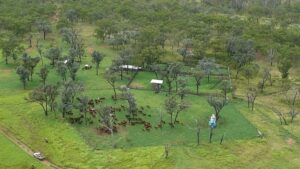Sometime this month Scott Morrison will announce a net zero by 2050 emissions-reduction target for Australia. This announcement will be made with the expectation of praise. However, much like the world was indifferent when Australia signalled it would no longer be using Kyoto credits to meet its Paris targets, so too will this announcement be dismissed. It’s not enough. The community, markets, state and territory governments and other world leaders have moved on and are demanding more.
In the lead-up to 2007, something similar happened to then prime minister John Howard. Years of intransigence on climate policy and a refusal to ratify the Kyoto Protocol meant state governments began to take up the slack and propose their own more ambitious action, even floating their own emissions trading scheme. Howard was left behind.
The election came and Kevin Rudd made John Howard look like yesterday’s man, unable to tackle future issues like climate change.
Five prime ministers later and on the eve of another election, Scott Morrison is in danger of looking like the Prime Minister of the past, as state governments of all political persuasions race past the federal government on climate action. Meanwhile, the Prime Minister is dithering on whether to even attend the November United Nations COP26 climate summit in Glasgow.
NSW Energy and Environment Minister Matt Kean’s announcement this week that NSW was going to halve the state’s emissions by 2030, with the Nationals’ support, landed like a bomb in the Prime Minister’s lap.
The NSW government announcement was not about 2050. It was about something happening this decade – what President Biden calls the “decisive decade” for climate change. This is where the global debate is at now. All the political dithering about net zero by 2050 at home completely misses the fact that COP26 is about short-term action. The goalposts have been shifted on the Prime Minister, by his own side of politics. Prime Minister Scott Morrison, seemingly beholden to the increasingly incoherent rantings of Deputy Prime Minister Barnaby Joyce, is beginning to look ridiculous.
The government is pushing one policy, though: public investment in “technology”. The parallels with the Howard playbook continue. Refusing to ratify the Kyoto Protocol, then-prime minister Howard spent his time finding partner countries to invest in technologies that supported the fossil fuel industry. The current iteration of this trick – “technology not taxes” – is so unimaginative it is even using the same technologies, like carbon capture and storage, and branding (remember “clean coal”? now we have “clean hydrogen”). This is instead of focusing on existing proven technologies, like renewables, that would drastically cut our emissions and lower costs.
It gets worse.
The other gaping hole with the government’s net zero plan will be the “net”. When the Prime Minister announces his plan, it will include a bucket of money to appease the Nationals. There will be money for soil carbon and further support for carbon and sector “offsets”. The government will purchase these offsets at considerable cost to the taxpayer, while industry will be encouraged to buy – and even be applauded for buying – carbon credits instead of actually reducing emissions. The great era of carbon offset rorts is upon us.
Recent research by the Australia Institute and the Australian Conservation Foundation has shown around 20 per cent of the official government-approved carbon credits (ACCUs) may not be genuine, because the offsets for “avoided deforestation” have been awarded for land that was never going to be cleared. Hundreds of millions of dollars have been spent by the government on these offsets, to claim it is “meeting and beating” its targets. There are huge questions over the integrity of offsets in Australia and globally, yet the government is still rushing through new offset methods to ensure it has ample offset supply to comfortably meet the “net” part of any net zero plan it announces.
“Net zero by 2050” will be seen as even more risible considering our expanding our coal and gas production. Australia’s key economic policy currently is a “methane-fired recovery”. The massive Adani mine is on track to ship its first coal in time for COP26. NSW alone currently has 20 new coal mines proposed for development. Government plans for new gas resources have an emissions profile equivalent to more than 40 new coal power stations. The Beetaloo Basin will look like swiss cheese thanks to the Beetaloo Cooperative Drilling Program. The government is even pushing ahead with a proposal to subsidise coal-fired electricity generation to keep it operating well past retirement age, despite widespread rejection of the mechanism from industry and state governments.
International expectations that Australia must do more on climate change will not be satisfied by a net zero 2050 target. Australia’s relationships with its key allies and trading partners are already tenuous thanks to our climate inaction. Closer to home we are going to see significant diplomatic fallout over Australia’s net zero fraud.
Despite years of rhetoric about supporting our “Pacific family”, Australia has resisted explicit calls from the Pacific to increase our climate ambition and phase out coal. As a new generation of leaders are elected in the Pacific, Australia will have to work hard to rebuild its relationship as a trusted friend and partner. On Wednesday October 6, the newly elected Honourable Fiame Naomi Mata’afa, Prime Minister of Samoa, will speak at the Inaugural Regional Climate Diplomacy Forum. Her first speech to an Australian audience since displacing her predecessor, who served for 22 years as leader, is tellingly focused on climate action in the Pacific.
It is not surprising the Prime Minister might want to stay at home rather than attend the Glasgow climate conference. In the lead-up to the conference, the UN, the UK and the United States have all called Australia out as a climate laggard, with escalating urgency. That’s before the official negotiations have even started. Setting a net zero by 2050 target alone is inadequate. Setting a net zero by 2050 target while expanding fossil fuel development is a fraud.
Between the Lines Newsletter
The biggest stories and the best analysis from the team at the Australia Institute, delivered to your inbox every fortnight.
You might also like
Here are 23 Times Carbon Offsets Were Found to be Dodgy
Carbon offsetting has received a lot of attention recently. As businesses and governments look to meet their climate targets, many are turning to carbon offsets. That is, they are paying someone else to reduce or avoid putting greenhouse gases into the atmosphere, so they don’t have to.
8 things Chris Bowen didn’t tell you about Australia’s climate failure
Chris Bowen, the Federal Minister for Climate Change and Energy, has presented the Annual Climate Change Statement to Parliament, but it didn’t tell the full story.
Why maintaining ambition for 1.5°C is critical | Bill Hare
One of the key things about this whole problem is that the only way to solve it is that we need to rapidly reduce and phase out fossil fuels. That can’t wait a decade. We need to be making substantial reductions this decade.



